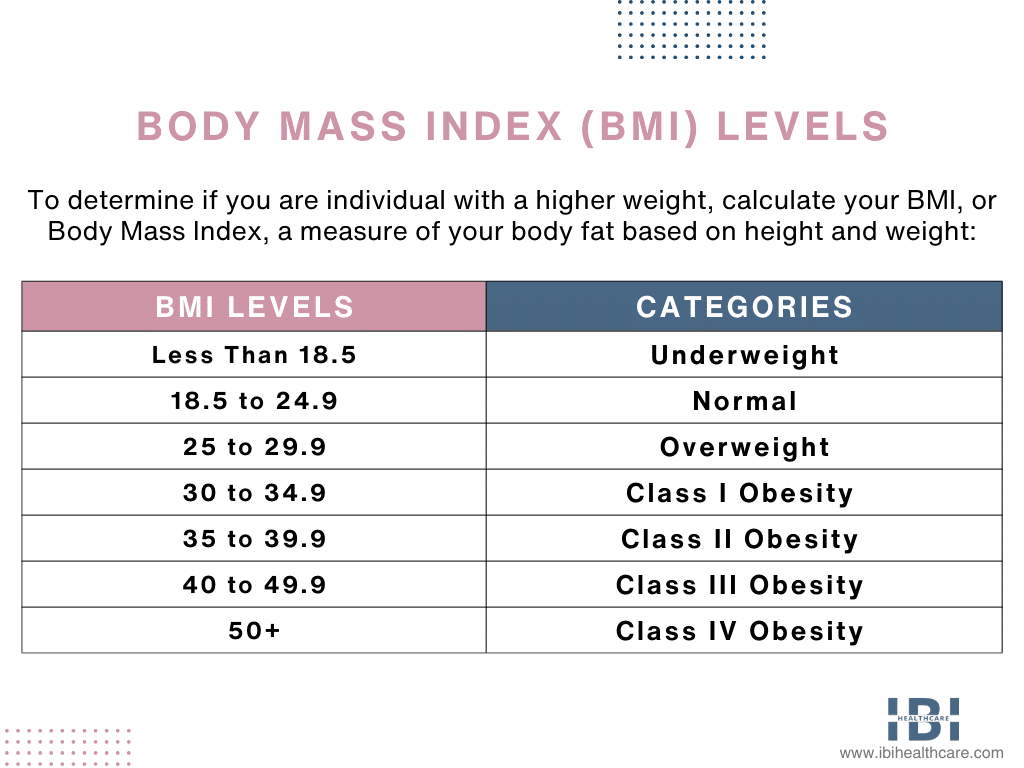Morbid obesity, also referred to as class III obesity, is a severe health condition with multiple chronic illnesses, side effects, and complications that significantly affect one’s quality of life. Fortunately, various treatment options exist to promote weight loss, improve overall health, and potentially reverse associated illnesses.
What is Morbid Obesity?
The World Health Organization (WHO) affirms that an elevated percentage of body fat (PBF) negatively impacts health and well-being in individuals.
The WHO declared morbid obesity a global epidemic due to the alarmingly high percentage of the world’s population suffering from this condition.
A BMI scale is universally used to indicate an individual’s level of body fat. The BMI scale consists of ranges that categorize individuals. According to the chart below, an individual with a BMI range of 40-49.9 would be classified as having morbidly high weight or class III obesity. You can quickly check your BMI using our BMI calculator.

Why did they change the name of Morbid Obesity to Class III Obesity?
Morbid obesity was first used to describe higher-weight individuals in 1963. The term was used in a communication that was written by Dr. J. Payne to convince health insurance authorities to cover the cost of intestinal bypass surgery.
Medical professionals use the word comorbidity to indicate that an individual has more than one disease or illness. They also use the phrases morbidly higher weight or morbid obesity to accurately describe an individual whose body weight has reached the point of causing health issues.
Like many words today, the word morbid has been misused to the extent that most people do not know its proper meaning. Today when we hear that word we think of disturbing, unpleasant, or even gross which portrays a negative connotation.
When people use the word morbid in conjunction with obesity, it contributes to the already misguided social stigma faced by the large group of individuals suffering from it. Multiple factors contribute to obesity, and individuals’ lack of willpower does not primarily cause it.
The World Health Organization (WHO), researchers, and healthcare professionals now use the term class III obesity to categorize individuals whose BMI is 40+.
How is Class III Obesity Diagnosed?
Generally, individuals who meet the following criteria are determined to suffer from morbid obesity or class III obesity.
- Their BMI is 40 or above.
- Have at least 100 pounds of excess weight compared to the healthy weight range for their height and gender.
- Their BMI is 35 or above and they suffer from one or more obesity-related health conditions, such as type 2 diabetes, or high blood pressure.
Diagnosing Class III Obesity with the BMI Chart
A mathematician developed the BMI chart in the 19th century to generally categorize a population. However, it was not initially intended for individual use.
The standard BMI chart does not consider the special circumstances of the following and can be inaccurate:
- Children.
- Older people over 65.
- Individuals with higher muscle mass.
- Bodybuilders & professional athletes.
Also, the standard BMI chart may be miscalculated for certain ethnic groups when calculating risks for health conditions.
Doctors and healthcare professionals use the BMI chart as an initial benchmark but also consider other criteria before deciding regarding a patient’s state of health.
Diagnosing Obesity Through Laboratory Tests
Additionally, your doctor might also consider conducting a panel of tests to identify any health conditions associated with weight gain or resulting from obesity. Some of the tests that could be conducted include:
- Liver.
- Lipids.
- Urinalysis.
- Sleep Study.
- Blood Count.
- CRP Protein.
- Kidney Function.
- Thyroid (TSH) Test.
- HbA1C Hemoglobin.
- Check Vitamin D Level.
- Metabolic Panel (Basic).
- Electrocardiogram (EKG).
What Causes Class III Obesity?
Class 3 obesity can have many contributing factors but it primarily comes down to our bodies storing more fat than it burns. What causes each individual to burn or retain more calories than their body uses can be simple or complex. The most well-known causes of weight gain are:
- Eating too much.
- Eating unhealthy foods.
- Lack of physical activity.
Other factors that can contribute to the predisposition of obesity are:
- Genetics.
- Environment.
- Cultural differences.
- Imbalance in hormones.
- Socio-economic or geographical.
What Conditions or Illnesses are Caused by Class III Obesity?
Class III obesity is associated with a plethora of serious health conditions, including:
Type 2 Diabetes
excess fat can cause insulin resistance. The risk of experiencing type 2 diabetes increases incrementally for each single point increase on the BMI scale.
Heart Disease
prolonged obesity affects the heart’s ability to function and facilitates heart disease.
Metabolic Syndrome
A combination of three or more conditions such as high blood pressure, elevated blood sugar levels, and high cholesterol.
High Blood Pressure
Hypertension is 3.5 times more likely to develop in higher-weight individuals making them more at risk for heart disease.
Atherosclerosis
Obesity can lead to the accelerated buildup of plaque in the arteries.
Sleep Apnea
Fat deposits in the upper respiratory tract can cause the breathing airway to narrow causing momentary breathing blockage during sleep.
Cancer
Obesity can increase an individual’s risk of developing 13 different types of cancer.
Obesity Hypoventilation Syndrome (OHS)
This breathing disorder that causes an imbalance of carbon dioxide to oxygen levels in the blood can cause serious health issues and can be life-threatening.
Osteoarthritis
Obesity creates stress and pressure on joints that the body is not capable of bearing for long periods.
Depression
Adults suffering from obesity have greater instances of depression.
What happens if one leaves morbid obesity untreated?
Morbid obesity can cause a myriad of serious health conditions but even more disturbing is that Class III obesity can shorten an individual’s life expectancy by 14 years.
How is Morbid Obesity Treated?
Treating class III obesity varies by the individual. Since there are many root causes of obesity, treatments differ so they can address these individually. Usually, treating an individual who is suffering from class III obesity involves multiple components including education, support groups, bariatric procedures, and:
Drastic Lifestyle Changes
A healthy diet, increased physical activity, getting an adequate amount of sleep, and stress management all contribute to weight loss and weight management;
Multiple Therapies
Behavioral and psychological support, and weight loss patients can address some of the root causes of obesity. Moreover, this support can assist as they navigate through weight loss surgery or strive to maintain a healthy lifestyle.
Medications
Sometimes, medications can be effective in helping to treat obesity. Furthermore, these medications can help decrease the appetite and the feeling of being hungry. Alternatively, they can also block the intestines from absorbing fat.
Bariatric Surgery to Treat Class III Obesity
Individuals who are suffering from class III obesity have a very low chance of attaining a healthy body weight without medical intervention. However, several surgical options may be viable choices to help an individual with a higher weight lose weight. To determine if you are a candidate for weight loss surgery and which choice would be best for you, we recommend having a consultation with a bariatric surgeon.
Laparoscopic Adjustable Gastric Band (LAGB)
During a Lap-Band surgery, a silicone band is inflated in the upper stomach to adjust size and position, effectively controlling food intake.
Gastric Sleeve Surgery (LSG or VSG)
LSG or VSG By surgically cutting away a portion of the patient’s stomach, the surgeon effectively shapes the remaining part into a pouch. As a result, the stomach’s size is reduced by approximately 75%, significantly limiting the amount of food they can consume. Consequently, this procedure promotes weight loss and offers long-term benefits.
Gastric Bypass
There are two ways that Gastric Bypass surgery helps a patient lose weight. The first similarity is that it permanently makes the stomach smaller, just like the gastric sleeve. The second difference is that it alters one portion of the digestive system in addition to reducing the stomach size. The surgeon re-routes part of the small intestine which inhibits the body from absorbing all calories the individual eats.
Laparoscopic Duodenal Switch Surgery
Patients who undergo Duodenal Switch surgery lose the most significant amount of weight. During duodenal switch surgery, the surgeon makes alterations to two sections of the digestive system, similar to how gastric bypass surgery makes the stomach smaller and reroutes the digestive system.
What Treatment is Available for Obesity Type IV (BMI Over 50)?
Sometimes, patients with very high BMI numbers can not undergo a surgical procedure due to health risks. In cases such as these, doctors often use a multi-step approach. They perform one non-invasive, low-risk procedure to help the individual lose some initial weight and then use another procedure or perform surgery to help them effectively lose more. We may use treatments for super higher weight individuals:
Orbera® Gastric Balloon
The procedure of placing a gastric balloon aims to optimize stomach capacity and prevent overeating. This procedure can use either a single balloon or multiple balloons. The medical professional introduces the balloons into the stomach through a straightforward procedure or by instructing the patient to swallow a capsule. Consequently, the doctor has the flexibility to regulate the size of the balloon(s) by effectively inflating or deflating them as required. Ultimately, gastric balloons serve as an effective tool in curbing excessive food intake.
Endoscopic Sleeve Gastroplasty (ESG)
ESG, similar to a gastric sleeve, is a non-surgical and reversible method for altering the patient’s stomach. By suturing, we make the stomach smaller and shape it like a pouch. Unlike surgery, we perform ESG through the throat, eliminating the need for incisions. It is a quick procedure that does not necessitate a hospital stay and has a short recovery period.
Though, Type III Obesity is a severe and potentially life-threatening condition. Even so, individuals can effectively manage it with the right treatments like weight loss surgery, therapy, and support. Moreover, weight loss surgery has proven to be successful in eliminating or significantly reducing obesity-related health problems, including type 2 diabetes.
However, if you are suffering from obesity or class III obesity, please contact IBI Healthcare Institute. Moreover, we are here to help you reclaim your health and your quality of life. Additionally, set up a consultation with one of our caring experts today and learn more about how we can create a custom plan to help you attain your weight loss goal.










